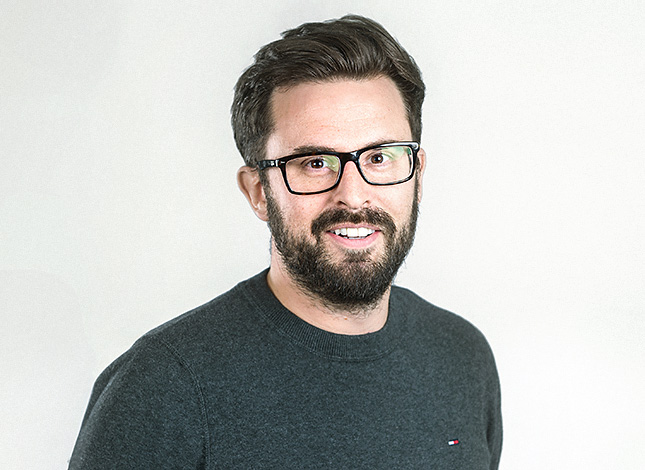Chris LeCompte works at his own company – Cavendo – working on web design, development, strategy and visibility. Chris can also be found regularly posting great articles on his site, Clecompte. Follow Chris on Twitter.
The Day Job
Tell me a little bit about the company you work for
I work at a small web design and development firm called Cavendo in the Washington D.C. metropolitan area, which I helped to form nearly 10 years ago while still in school. We focus on both large and small projects in a variety of industries, and we have established pretty deep roots in our local community.
What is the ratio of digital project managers to production staff at your company?
Since our company is small, I typically wear the hat of the Digital Project Manager, designer, and in some cases, developer – this requires some extreme self-discipline on my part.
In planning for growth, I envision a healthy ratio of one Digital Project Manager to four or five production staff members. Any larger than that, and I fear there would be a loss of cohesion in the team. As clichéd as it may sound, good Digital Project Managers really are the glue that bonds the team.
Do you use any particular project management methodologies? If so, why? If not, why?
I don’t follow any one defined methodology. Rather, I just take pieces from them. Most set methodologies just seem cumbersome for a company of our size. Our typical projects follow a routine of project research, proposal write-up, client initiation, project work, project launch, and post-launch analysis. Woven throughout that are multiple points of contact with the client and other parties as well as numerous deliverables.
What online or offline tools do you tend to use for digital project management?
There seems to be a tool for every possible part of a digital project, so here’s the abridged version of my list. For global project management including client communication, milestones, and to-do lists, I use Basecamp.
For internal client management, Highrise and Salesforce. I track project time (very important) using Harvest. I wireframe using MockFlow. Scheduling is co-ordinated through Google Calendar. And finally, support for post-project hiccups is managed via a ZenDesk ticketing system.
How on earth did you end up managing digital projects? Few people start out with this aim. Tell me how you wound up being a full-time punch bag?
I never asked to be a Digital Project Manager. Instead, I came to accept the responsibility of wearing multiple hats. Sometimes I’m designing mock-ups while other times I could be communicating with subcontractors or talking to a client on the phone about some new ideas.
Through wearing these hats, I discovered that I was indeed a Digital Project Manager, and I’ve come to really enjoy it – even while taking some punches!
Do you just manage digital projects or is your role varied? If so, what other roles do you perform?
Beyond managing digital projects, I’m also the lead designer for my firm. That means when I’m not meeting with clients, I’m designing in Photoshop or programming code for WordPress.
What type of digital projects do you typically work on?
Most of the digital projects I work on are site overhauls or completely new site designs and rollouts. This involves in-depth communication with the client about what they want to accomplish with the site.
Next, planning is done to prepare for the designing of the site. After that, the site is programmed and integrated with the selected content management system. The site is launched and training is usually conducted to familiarise the client with the CMS.
How many digital projects are you currently managing? What’s the most you’ve ever managed at any one time?
At the moment, I’m currently managing about 10 projects of varying sizes. This is actually on the low side, and at peak, I can expect to be managing upwards of 15 to 20 projects.
What percentage of a digital project’s total budgeted hours would you typically spend on project management?
I actually record digital project management activities as separate tasks in Harvest, and I calculate I spend roughly 25% of the project managing it. I will invest a good chunk of that time upfront to ensure the rest of the project goes smoothly.
What digital projects are you working on right now, and what digital project are you most proud of to date?
One of the digital projects we’re currently working on includes a big site overhaul for a credit union (basically gutting their existing site and moving it to a new system). We’re also working on a new site for a government contractor and a wind chime manufacturer – talk about variety!
I’m generally proud of all the projects I work on, but I would say the one that stands out most recently is a site we developed for Metro Sign & Design, a sign manufacturer and installer. Project went smoothly and it was loads of fun to work on.
Describe a typical day in the life of your role managing digital projects.
Obviously, there is no such thing as a typical day for a Digital Project Manager, but I can give you a rough sketch. Usually, I’ll start the day by writing out the projects and clients I need to either work on or review. I spend the rest of the day working my way through this list while dealing with surprise telephone calls, emails, requests, and other unforeseeable events.
How would you describe your managerial style?
I hate to admit this, but I can be a bit of a control freak. As a web designer, it can be hard to shift over to the Digital Project Manager role. My need as a designer to have everything pixel-perfect sometimes translates over to my projects.
When I can control my control freak problem – odd as it may sound – I follow a fairly laid back managerial style. I’m fine with people working on their own hours with the tools they prefer as long as the work is completed on time and within the scope of the project.
What are the common things that crop up on a daily basis that destroy your planned activities for that day?
Everything from phone calls to unanticipated visitors. I try to leave in enough time daily to allow for these distractions while still getting project work done. I’ve adapted for the most part since it’s just part of the game.
How do you keep organised personally, given the hectic life that comes with managing digital projects?
I organise my digital projects and to-do items using software (e.g. Basecamp and Remember The Milk). I also use my email to flag important messages that I need to follow-up on, and good, old pen and paper is useful for jotting down important reminders. It’s not always easy, but as long as I can keep things prioritised in my mind, I can juggle multiple activities throughout the day.
The Projects
At what point do you typically get involved with a digital project you are to manage? Pre-sales and estimating or only post-sale?
I work the full gamut of the digital project, from helping the sales side determine a quote and scope to on-boarding new clients, to actually running and completing the digital project. I also provide support to clients post-project to assist with any issues.
What technique do you use to estimate digital projects? Do you use different ones for small and large projects?
There is no technique per se, just an analysis of the digital project, development of a scope and an estimation of the time it will take to launch.
How do you handle unrealistic digital project budgets and schedules?
I handle these issues by being honest. Since I’m very involved in the digital project process, I know what’s possible and what’s not. If I perceive a proposed budget or schedule as being unrealistic, I’ll make sure the point is known and then provide a counter-proposal – if we can’t make it work under any circumstance, it’s time to move on.
How does your company approach scheduling all the work currently in the pipeline?
Scheduling is all about milestones. The more immediate milestones for a particular week take priority, are completed, and then the next week is tackled.
You receive a new digital project to manage, what are the first steps you’ll take?
On-boarding the client is the first step. During this process, I reach out to the new client, introduce myself, and introduce them to our digital project management software. I’ll review the questionnaire and supporting documents completed by sales, and notate my questions and points to touch on. After that, I’ll either have a conversation with the client or get the balling rolling on the digital project work.
Do you manage all aspects of digital projects, like design, front-end and back-end development, or do department leads manage production based on requirements you capture?
We’re small. I manage it all!
What deliverables do you personally typically produce on a digital project? Sitemaps, wireframes, functional specifications? Or are these produced by someone else? If so, who?
Sitemaps, wireframes, scopes of work and feasibility analyses are the usual documents I produce.
What are all the things that will be defined and approved before design or development begins on one of your digital projects?
A handful of activities need to take place before a digital project can commence. Discussions with the client obviously need to take place, and from that, a scope of work is generated. This scope is then used to build a proposal that accurately encompasses the full extent of the project.
How do you tackle the art of monitoring digital project budgets versus progress?
To monitor budget versus progress, I use the tracker in Harvest to alert me whenever a project reaches a certain percentage of the budget. I can then review potential problem projects before they spiral out of control.
How do you manage the inevitable scope creep on digital projects?
The best weapons against scope creep are preventative. For example, defining a scope of work beforehand can help combat against unforeseen expectations. The most important way to prevent scope creep, however, is communication. This can be a scary thing for some people, but actually confronting and talking to clients before an issue occurs is essential.
After that, you’re just reacting, which is even more painful. When issues do happen, forcing me to react, I simply express these concerns to the client in an open manner so that we can settle on a compromise.
What advice would you give for managing difficult clients?
Open and active communication is the best way to deal with difficult clients. Don’t take abuse personally, and if you do screw up on a digital project, be ready and willing to make it right. Many difficult clients come across as a pain because they don’t understand the process – communication alleviates this.
Also, protecting yourself is essential. Always document communication, and make sure you have an airtight contract. And yes, clients can be wrong, and they can also be fired.
How do you ensure past mistakes on digital projects never happen again?
I wish I could say there was a way, but there isn’t – we’re all doomed to repeat mistakes – but of course, there is at least a way to reduce our chances of making the same errors. For me, it’s all about learning and adapting.
My biggest mistakes tend to be in the communication area. Sometimes I don’t communicate enough, or I don’t communicate something correctly. To overcome this, I make mental notes and try to program changes into my behaviour – I’ll even implement changes to processes if necessary.
Sometimes, I’ll write a blog post about a mistake made on a project as a good case study. Writing about your mistakes is an excellent way of helping you think more thoughtfully about them.
The Big Questions
What websites, blogs and podcasts are you currently using regularly for inspiration?
There are so many great resources out there that it’s impossible to list them all, but here are a few of my favourites.
- Better Projects
- Herding Cats
- Project Shrink
- Kareem’s Blog
- PM Student
- Dumb Little Man
- Pick The Brain
- 456 Berea St.
- Smashing Magazine
- The Design Cubicle
- Boagworld
- And of course The Sam Barnes
And Twitter is a great resource as well for those mini-conversations.
What are the biggest differences between managing website projects and web application projects?
There’s more room for flexibility in web site projects, in my opinion. When you get into web applications, there are very specific features that must be hashed out and put into writing.
What do you think are the key personality attributes required to be a good digital project manager?
Good communication, affable, flexible and knowledgeable in a wide variety of areas.
What are the biggest common misconceptions about digital project management?
That we have all the answers, all the time, and that we can implement anything, anytime.
What, in your opinion, is the hardest part of digital project management?
Communicating.
In three words, how would you describe digital project management?
I control everything. (insert evil grin >:-)








Really interesting article. Tracking your time is definitely important, so you should get a tool that serves your needs. I really like TimeSheet Reporter (http://www.timesheetreporter.com), since it allows me to track time via Outlook.
Thanks.